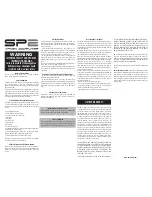
Section 2: Connections and configuration
Model 4200A-SCS Parameter Analyzer Reference Manual
2-4
4200A-901-01 Rev. C / February 2017
Figure 5: Device guarding basic circuit
Signal integrity
To maintain signal integrity, especially at low current levels, consider the following when making
signal connections between the 4200A-SCS instrumentation and the device under test (DUT):
•
Use only low-noise triaxial cables such as those provided with the SMU (4200-MTRX-X) and
preamplifier (4200-TRX-X).
•
Keep connecting cables as short as possible.
•
Avoid flexing or vibrating connecting cables while making measurements.
•
Do not touch connector insulators. Be sure to keep all connector insulators clean to minimize
contamination-induced leakage currents.
•
Avoid stresses in cables. Do not allow large portions to hang under their own weight. Place on a
table or flat surface if possible. Avoid tight bends in the cables.
Refer to
(on page 12-1) or the
Keithley Instruments Low Level Measurements
Handbook
for more information about measurement integrity.
SMU connections
The SMU can be connected directly to the device under test (DUT) with triaxial cables using either
local or remote sensing, as described below. Remote sensing is typically used when currents exceed
1 mA and the FORCE path resistance is large (around 1 Ω). In this case, as much as 1 mV (= 1 mA
×
1 Ω) of measurement error is generated due to FORCE path resistance. Remote sensing eliminates
these errors.
When using more than one SMU, use the ground unit for circuit COMMON connections instead of
the outer shield of the SMU terminals. Refer to
(on page 2-8).
















































